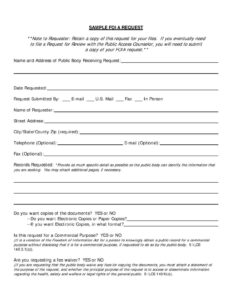Utilizing such a structure increases the likelihood of a successful application. It helps requesters avoid common pitfalls, such as omitting crucial information, and can expedite the processing time by presenting the request in a readily understandable format. This streamlined process benefits both the applicant and the agencies responsible for providing the information.
This foundation is essential for understanding the broader topics of transparency, accountability, and public access to information. Further exploration of these areas will provide a comprehensive understanding of the importance of open government and the tools that support it.
Key Components of an Effective Access Request
Well-crafted applications for government-held information typically incorporate several essential elements to ensure clarity and completeness.
1: Requester Information: Clear identification of the individual making the request, including full name, address, and contact information, facilitates communication and efficient processing.
2: Agency Identification: Specific identification of the government body holding the requested information is crucial for routing the request correctly and avoiding delays.
3: Detailed Description of Information: A precise and unambiguous description of the specific documents or data sought increases the likelihood of a successful retrieval. Vague or overly broad requests can hinder the process.
4: Preferred Format: Specifying the desired format for receiving the information (e.g., electronic copy, paper copy) aids in efficient delivery and ensures compatibility with the requester’s systems.
5: Date Range (if applicable): If the request pertains to information within a specific timeframe, clearly defining the start and end dates helps narrow the search and improves retrieval accuracy.
6: Fee Waiver Request (if applicable): If eligible for a fee waiver based on specific criteria, including public interest or financial hardship, a clear and justified request should be included.
7: Signature and Date: Formalizing the request with a signature and date affirms the requester’s commitment and provides a timestamp for the application.
These elements ensure efficient processing, increase the probability of receiving the requested information, and contribute to a smoother interaction between the public and government agencies.
How to Create a Request for Government-Held Information
Creating a structured application for accessing government records requires careful attention to detail and a clear understanding of the necessary components. The following steps offer guidance in developing a comprehensive and effective request.
1: Template Selection: Begin by locating a suitable template. Many government agencies provide templates on their websites or upon request. A template ensures all essential information is included and presented in a clear format. If a pre-designed template is unavailable, one can be created using standard word processing software.
2: Personal Identification: Accurately provide full name, current address, and preferred contact information (phone number, email address). Accurate contact information is essential for correspondence and delivery of requested materials.
3: Agency Specificity: Clearly identify the specific government agency believed to hold the desired information. This includes the agency’s full name and any relevant department or subdivision. Addressing the request to the correct agency avoids unnecessary delays.
4: Information Description: Provide a precise and detailed description of the requested records. Avoid vague or overly broad language. Specific dates, titles, document types, or keywords relevant to the information sought will streamline the retrieval process.
5: Format Preference: Indicate the preferred format for receiving the information, such as electronic copies (PDF, Word document), paper copies, or other available formats. Specifying a preferred format ensures compatibility and usability.
6: Timeframe Specification (if applicable): If the request pertains to a specific period, define the relevant start and end dates. Restricting the timeframe, when applicable, narrows the scope of the search and facilitates more efficient retrieval.
7: Fee Waiver Considerations: Explore potential eligibility for a fee waiver. Many jurisdictions offer waivers based on demonstrable public interest or financial hardship. If applicable, include a clear and reasoned justification for the waiver request.
8: Review and Submission: Before submission, thoroughly review the completed application to ensure accuracy and completeness. Submit the request according to the agency’s specified procedures, which may include online portals, mail, or fax. Retaining a copy of the submitted request is recommended.
A well-prepared application, incorporating these components, significantly increases the likelihood of a successful outcome. This meticulous approach facilitates transparency and accountability within government operations.
Structured frameworks for requesting government information provide a crucial mechanism for promoting transparency and accountability. These templates, by streamlining the application process and ensuring clarity in communication, empower individuals to access information vital for informed civic engagement. Understanding the components of a well-crafted request, coupled with a clear process for submission, increases the likelihood of successful retrieval and contributes to a more open and accessible government.
Access to information remains a cornerstone of a functioning democracy. Leveraging available tools, such as structured request templates, strengthens this foundation and fosters a more informed and engaged citizenry. Continued emphasis on accessible information empowers individuals and contributes to a more transparent and accountable government for the benefit of all.

